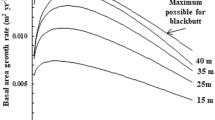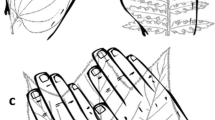Abstract
A field-oriented competition index (Shade Index) was developed using a series of mensurational measurements on competitors surrounding individual jack pine seedlings. This index and accompanying software were developed for a hand-held microprocessor, allowing for on-site evaluations.
The Shade Index estimates the percent occupancy of competitor crowns overtopping individual jack pine seedlings within a 1.4 m radius of the subject tree. Using 360 crop treecentred plots situated on six four-year-old plantations, the accuracy of the index was tested against a more complex competition index (Total Canopy Cover) obtained from vertical hemispherical photographs. Both of these indices attempt to quantify the amount of light being intercepted by competitors. A relationship was found to exist between these two indices with Pearson correlation coefficients ranging from 0.82 to 0.90. Linear regression models of seedling diameter regressed against the Shade Index for the different site/stock type combinations are presented. All models were significant at greater than p=0.0001, with coefficients of determination ranging from 0.42 to 0.71.
This index was incorporated into software for a hand-held microprocessor to allow on-site evaluation. These evaluations have the potential to be used to set tending priorities or assess vegetation control measures.
Similar content being viewed by others
References
Anonymous. 1987. Tree improvement master plan for Ontario. Queen's Printer for Ontario. Toronto, Ontario, Canada.
Anonymous. 1990. Summary of timber harvested on crown lands by species. Ont. Min. of Nat. Resources, Forest Management Branch, Forest Resources Group, Sault Ste. Marie, Ontario, Canada.
Bonhomme, R. and Chartier, P. 1972. The interpretation and the automatic measurement of hemispherical photographs to obtain sunlit foliage area and gap frequency. Israel J. Agric. Res. 22: 53–61.
Brand, D. G. 1986. A competition index for predicting the vigour of planted Douglas-fir in southwestern British Columbia. Can. J. For. Res. 16: 23–29.
Brand, D. G. 1988. A systematic approach to assess forest regeneration. For. Chron. 64: 414–420.
Burdett, A. N., Herring, L. J. and Thompson, C. F. 1984. Early growth of planted spruce. Can. J. For. Res. 14: 644–651.
Cannell, M. G. R., Rothery, P. and Ford, E. D. 1984. Competition within stands of Picea sitchensis and Pinus contorta. Ann. Bot. 53: 349–362.
Chan, S. S., McCreight, R. W., Walstad, J. D. and Spies, T. A. 1986. Evaluating forest vegetative cover with computerized analysis of fisheye photographs. For. Sci. 32: 1085–1091.
Daniels, R. F. 1976. Simple competition indices and their correlation with annual loblolly pine tree growth. For. Sci. 22: 454–456.
Fowells, H. A. 1965. Silvics of forest trees of the United States. USDA, For. Serv., Agr. Handb No. 271. Washington, D.C., USA.
Hosie, R. C. 1979. Native trees of Canada. Fitzhenry & Whiteside Ltd., Toronto.
Kabzems, A. and Kirby, C. L. 1956. The growth and yield of jack pine in Saskatchewan. Saskatchewan Dept. Nat. Resources, Forestry Branch Tech. Bul. 2. Regina, Saskatchewan, Canada.
Lorimer, C. G. 1983. Tests of age-independent competition indices for individual trees in natural hardwood stands. For. Ecol. Manage. 6: 343–360.
MacDonald, G. B., Morris, D. M. and Marshall, P. L. 1990. Assessing components of competition indices for young boreal plantations. Can. J. For. Res. 20: 1060–1068.
McClain, K. M. 1981. Definition and distribution of the boreal mixedwood forest in Ontario. In: Whitney, R. D. and McClain, K. M. (Eds) Boreal mixedwood symposium. Canadian Forestry Service, Great Lakes Forest Research Centre, Sault Ste Marie, Ontario. COJFRC Symposium proceedings 0-P-9.
Mitchell, R. J., Zutter, B. R. and South, D. B. 1988. Interaction between weed control and loblolly pine, Pinus taeda, seedling quality. Weed Technol. 2: 190–195.
Morris, D. M. and MacDonald, G. B. 1991. Development of a competition index for young conifer plantations established on boreal mixedwood sites. For Chron. 67: 403–410.
Morris, D. M., MacDonald, G. B. and McClain, K. M. 1990. Evaluation of morphological attributes as response variables to perennial competition for four-year-old black spruce and iack pine seedlings. Can. J. For. Res. 20: 1696–1703.
Olsson, L. K., Grip, C. H. and Perttu, K. 1982. Evaluation of forest-canopy photographs with diode-array scanner OSIRIS. Can. J. For. Res. 12: 822–828.
Reed, K. C., Shumay, J. S., Walker, R. B. and Bledsoe, C. S. 1983. Evaluation of the interaction of two environmental factors affecting Douglas-fir seedling growth: light and nitrogen. For. Sci. 29: 193–203.
Rejmanek, M. and Messina, J. J. 1989. Quantification and prediction of woody weed competition in ponderosa pine plantations. In: Multiresource management of ponderosa pine forests; Nov. 14–16, 1989; Flagstaff, Az. Tech. Co-ords.: Tecle, A., Covington, W. W. and Hamre, R. H. Rocky Mtn. For. and Range Exp. Stn., USDA For. Serv. Gen. Tech. Rep. RM-185. Ft. Collins, CO, pp. 97–102.
Scale, D. M. 1989. Electronic data collection for tomorrow's forest. For. Chron. 65: 370–371.
Simard, S. 1990. A retrospective study of competition between paper birch and planted Douglas-fir. Canada-British Columbia forest resource development agreement report No. 147.
Tappeiner, J. C. and Wagner, R. G. 1987. Principles of silvicultural prescriptions for vegetative management. In: Walstad, J. D. and P. J. Kuch (Eds) Forest Vegetation Management for Conifer Production. John Wiley and Sons, New York. pp. 399–429.
Wagner, R. G. and Radosevich, S. R. 1987. Interspecific competition indices for vegetation management decisions in young Douglas-fir stands on the Siuslaw National Forest: Report No. 1. Oregon State Univ., Dep. For. Sci., Corvallis, Oregon.
Waller, D. M. 1981. Neighborhood competition in several violet populations. Oecologia 51: 116–122.
Zutter, B. R., Gjerstad, D. H., and Glover, G. R. 1986. Effects of interfering vegetation on biomass, fascicle morphology, and leaf area of loblolly pine seedlings. For. Sci. 32: 1016–1031.
Author information
Authors and Affiliations
Rights and permissions
About this article
Cite this article
Morris, D.M., Forslund, R.R. A field-oriented competition index for young jack pine plantations and a computerized decision tool for vegetation management. New Forest 5, 93–107 (1991). https://doi.org/10.1007/BF00029301
Received:
Accepted:
Issue Date:
DOI: https://doi.org/10.1007/BF00029301




